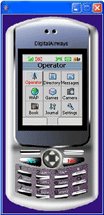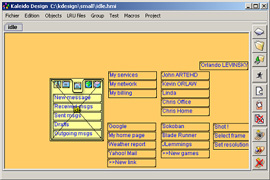Library speeds phone interface development
Feb 18, 2005 — by LinuxDevices Staff — from the LinuxDevices Archive — views Targeting low-end to mid-range mobile phones and handheld devices with communications capabilities, Kaleido Phone Library from Digital Airways provides customizable modules that accelerate MMI (man-machine interface) development for Nucleus and Linux platforms. A middleware “foundation layer” for MMI development, KPL is an extension to the Kaleido product introduced last year.
Targeting low-end to mid-range mobile phones and handheld devices with communications capabilities, Kaleido Phone Library from Digital Airways provides customizable modules that accelerate MMI (man-machine interface) development for Nucleus and Linux platforms. A middleware “foundation layer” for MMI development, KPL is an extension to the Kaleido product introduced last year.
 The mobile phone market has become a sweet spot for embedded Linux due to cost sensitivity combined with functionality/flexibility demands. According to Philippe Silberzahn, CEO and co-founder of Digital Airways, a key challenge for handset manufacturers is the design and implementation of the MMI as phones become “ever more sophisticated,” time-to-market pressures increase and the need for flexibility rises “as manufacturers are faced with the need to better respond to rapid changes, especially in the consumer market, which is driven by the operators' objective of ensuring a better user experience. In short, manufacturers need to more rapidly design and produce phones that are more and more complex.”
The mobile phone market has become a sweet spot for embedded Linux due to cost sensitivity combined with functionality/flexibility demands. According to Philippe Silberzahn, CEO and co-founder of Digital Airways, a key challenge for handset manufacturers is the design and implementation of the MMI as phones become “ever more sophisticated,” time-to-market pressures increase and the need for flexibility rises “as manufacturers are faced with the need to better respond to rapid changes, especially in the consumer market, which is driven by the operators' objective of ensuring a better user experience. In short, manufacturers need to more rapidly design and produce phones that are more and more complex.”
Kaleido provides a suite of applications to help mobile phone manufacturers design, implement and test MMIs. The new KPL provides what the company calls “a unified MMI base upon which all further applications may be integrated coherently to create feature-rich mobile devices.”
Available in C and Java, KPL consists of three major components:
- An MMI “framework” with such elements as Home and Idle screens, layout management, indicator management, phone settings, camera, storage and directory handling, events management, and language management
- A series of basic integrated applications, such as call and SMS management, dialer, phone book, sounds and picture albums, RSS reader, etc.
- A package of generic plug-ins for advanced native functions such as dynamic menu management, list processing, graphic effects, scroll bars, input methods, and dynamic bitmap creators

Kaleido design tool interface
The KPL is delivered as customizable modules, which allows the developer to encapsulate and integrate third party libraries and products such as browsers, MMS clients, 3D renderers, etc. under a common user interface. This, said Silberzahn, “enables manufacturers to select the best applications and technologies, and assemble them into a coherent software platform while maintaining complete control over branding and user interface design.”
Kaleido separates the MMI specification from its implementation, Silberzahn added, “unlike other MMI solutions based on automated code generation or the provision of MMI-specific code libraries.” With Kaleido, in contrast, “the MMI is fully specified with parameter files, which are read and duly rendered by the Kaleido MMI engine implemented on the handset. This makes it easy for manufacturers to adapt existing models to new MMI requirements without engaging in a complete design cycle.”
This article was originally published on LinuxDevices.com and has been donated to the open source community by QuinStreet Inc. Please visit LinuxToday.com for up-to-date news and articles about Linux and open source.